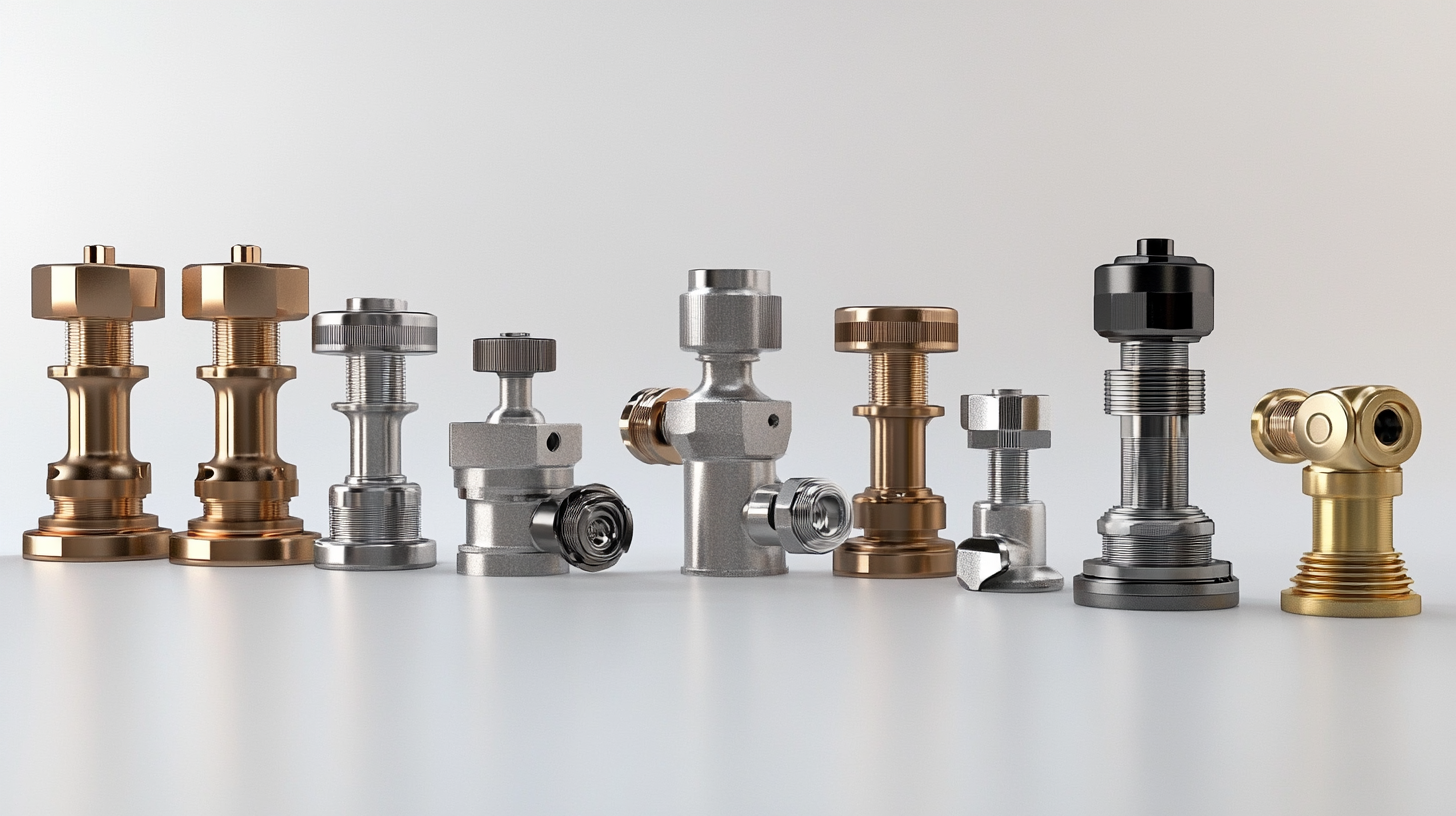In the world of plumbing and fluid control, the selection of the right stop valve can significantly influence the efficiency and reliability of a system. Among the various options available, the Angle Stop Valve stands out as a versatile and essential component for managing water flow in both residential and commercial applications. With a unique design that allows for directional adjustments, the Angle Stop Valve is not only functional but also adaptable, making it an ideal choice for global sourcing needs.
As businesses and contractors navigate the complexities of sourcing plumbing components from around the world, understanding the different types of stop valves, including the Angle Stop Valve, is crucial. This blog will explore the diverse range of stop valves available in the market, highlighting their features, benefits, and applications. By recognizing the significance of each type, particularly the Angle Stop Valve, you can make informed decisions that enhance your plumbing projects and ensure smooth operation across various industries.

Stop valves play a critical role in various industries, serving as essential components for regulating and controlling fluid flow. These valves are designed to either permit or obstruct the passage of fluids, making them indispensable in systems where flow control is vital. From water supply networks to oil refineries, the reliable operation of stop valves ensures that processes run smoothly and safely. Their ability to stop the flow of liquid or gas quickly is crucial in emergencies, highlighting their importance in maintaining system integrity and preventing accidents.
In the manufacturing and industrial sectors, the need for different types of stop valves arises due to varying operational requirements and environmental conditions. For instance, globe valves are often used for their excellent throttling capability and ease of maintenance, while gate valves are favored for applications requiring minimal flow resistance. Additionally, the introduction of innovative materials and designs has expanded the functionality of stop valves, making them suitable for high-pressure and high-temperature applications common in chemical processing and energy sectors.
Moreover, the selection of appropriate stop valves can significantly impact the efficiency and sustainability of operations. By ensuring optimal performance and reducing leakage, these valves contribute to energy savings and reduce operational costs. As industries continue to innovate and expand globally, understanding the various types of stop valves and their applications becomes essential for effective global sourcing strategies, ensuring that companies can meet their fluid control needs with confidence.
| Valve Type | Material | Application | Pressure Rating | Connection Type |
|---|---|---|---|---|
| Gate Valve | Cast Iron | Water Supply | 150 psi | Flanged |
| Globe Valve | Bronze | Oil and Gas | 300 psi | Threaded |
| Ball Valve | Stainless Steel | Chemical Processing | 600 psi | Welded |
| Check Valve | PVC | Wastewater | 180 psi | Slip-on |
| Butterfly Valve | Aluminum | HVAC | 200 psi | Flanged |
When it comes to global sourcing, understanding the various types of stop valves is crucial for ensuring efficiency and safety in fluid control systems. Among these, ball valves stand out for their exceptional durability and effective sealing capabilities. This type of stop valve is commonly used in applications that require rapid on/off control of flow, making it a preferred choice across various industries.
The latest market analysis projects that the global ball valves market will reach a size of USD 22.5 billion by 2033, with a compound annual growth rate (CAGR) of 4.7%. This growth trend indicates an increasing demand for efficient fluid control solutions, which highlights the importance of selecting the right type of stop valve in your sourcing strategy. Not only do ball valves provide reliability in high-pressure applications, but they also come in different designs, including floating and trunnion types, to meet diverse operational needs.
In addition to ball valves, other types of stop valves such as gate, globe, and check valves also play a pivotal role in various applications. Each valve type offers unique advantages, impacting factors like flow capacity, pressure drop, and installation requirements. For global sourcing professionals, an in-depth understanding of these valves helps optimize procurement strategies, ensuring the best performance and value for their operations. As the market continues to evolve, staying informed about these key types of stop valves is essential for meeting operational demands effectively.
When selecting stop valves for your business, it's crucial to consider various factors that can influence both operational efficiency and cost-effectiveness. One significant aspect is the type of media the valve will control. According to a report by MarketsandMarkets, the global industrial valve market is expected to reach $100 billion by 2025, driven primarily by increased demand in oil and gas applications. Therefore, choosing a valve that can handle specific media—whether it's water, oil, or chemicals—is essential for optimizing valve performance and longevity.
Another vital consideration is the valve's size and pressure rating. The American Society of Mechanical Engineers (ASME) stipulates that proper sizing and pressure ratings are critical in preventing malfunctions and ensuring compliance with safety standards. A well-chosen stop valve can reduce energy consumption and maintenance costs significantly. For instance, a poorly sized valve can lead to excessive wear or inadequate performance, which may cost businesses substantially when it's time for repairs or replacements.
Material selection is equally important; the valve's material must withstand the operational environment's temperature and pressure conditions. The global valve market is witnessing a shift towards high-performance materials, which are anticipated to dominate approximately 70% of the market by 2024, as reported by Research and Markets. Valves made from materials like stainless steel or high-strength alloys are not only durable but can also enhance performance in corrosive or high-temperature environments, offering a better return on investment over time.

When it comes to selecting stop valves for various industrial applications, understanding the differences between cast iron, stainless steel, and brass is crucial. Each material offers unique properties that make it suitable for specific environments. For instance, cast iron is renowned for its durability and high pressure resistance, making it ideal for heavy-duty applications. Recent market analysis indicates that the demand for cast iron valves remains strong in sectors such as water supply and wastewater treatment, where they can withstand harsh conditions.
On the other hand, stainless steel stop valves are favored in industries that require corrosion resistance, such as food processing and pharmaceuticals. The material's ability to maintain integrity under both high and low-temperature conditions has led to an increase in its utilization. In fact, industry reports suggest that the stainless steel valve market is projected to grow significantly due to heightened regulations on product safety and hygiene.
Brass stop valves, known for their excellent machinability and aesthetic appeal, are often used in plumbing and residential applications. They provide a good balance of strength and affordability, making them a popular choice among contractors. Recent studies show an expanding market for brass valves in residential construction as more households invest in modern plumbing systems.
As industries continue to evolve, the need for efficient and reliable stop valves will persist. The liquid hydrogen valve market, for example, is expected to expand significantly due to the increasing focus on renewable energy sources and storage solutions. As technological advancements unfold, the competitive landscape among valve manufacturers will likely intensify, driving innovation in design and materials.
When sourcing stop valves globally, it's essential to adopt best practices to ensure quality and reliability. Understanding the different types of stop valves available is the first step. There are various styles—gate, globe, ball, and check valves—each serving unique functions in fluid flow control. Identifying the right type for your specific application involves evaluating factors such as pressure ratings, material compatibility, and the environmental conditions in which they will be used.
Furthermore, maintaining good relationships with suppliers is crucial for effective sourcing. Regular communication can help you stay informed about new products and innovations in valve technology. Visiting manufacturing plants or local suppliers can provide insights into their quality control processes and manufacturing standards, ensuring that you select a partner committed to excellence.
Additionally, consider the importance of compliance with international regulations and standards when sourcing stop valves. Awareness of certifications like ISO, API, or ASME can significantly influence your selection process. By incorporating these practices into your sourcing strategy, you will be well-equipped to navigate the complexities of global supply chains while maintaining high operational standards in your applications.

